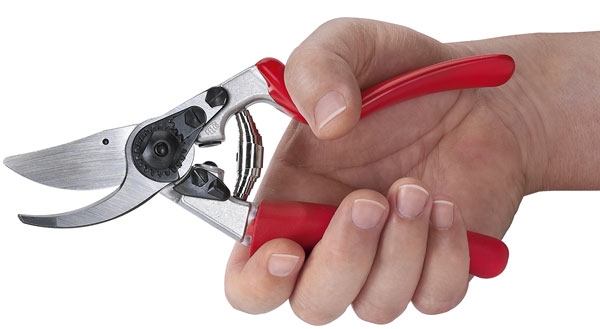Secateurs are subject to considerable mechanical stresses. Their performance is therefore greatly influenced by how well they are looked after.
A poorly-maintained pair of secateurs requires more effort, cuts poorly, and wears faster than a well-maintained tool.
The golden rule for all types of pruning tools, including Felco electric and pneumatic secateurs, is to keep them clean, sharp and well-oiled.
This article is focused on hand tools. Operators can maximise performance by following these simple and easy maintenance steps:
Daily blade clean-up
This protects against dirt build-up, preventing hardened particles from wedging between the cutting blade and the anvil-blade.
Clean the blades daily, using a dry cloth or a wire brush. Sap build-up can be removed beforehand with warm soapy water.
In addition, it is recommended to dismantle the secateurs a few times each season in order to be able to clean and dry all parts thoroughly.
Daily lubrication
Lubrication reduces friction, cleans impurities, avoids corrosion and prevents premature wear.
Most light oils such as sewing machine oil are suitable for secateurs. Thicker oils are less desirable. The recommended daily routine is as follows:
After cleaning the blades, oil the inside of the blade near the central bolt, and operate the secateurs several times to ensure that the oil penetrates into the central bolt area.
Oil the coils of the spring, also followed by a repeated action of the tool.
Felco rotating handles only: pull out the rotating handle and apply a few oil drops into the handle. The rotating handle must always swivel freely.
Blade sharpening
A sharp blade reduces effort and causes less damage to plant tissue.
Sharpen the blade as soon as cutting requires more effort, or when the tool stops cutting small twigs cleanly.
A Felco diamond-coated sharpening tool or ceramic stone, permit sharpening without dismantling the secateurs, as follows:
Open the secateurs, remove the spring. Work on the outside bevel of the blade first, holding the stone at a 23° angle, (as per the original blade bevel) in short motions going from the inside to the extremity of the blade. Maintain the curve (radius) of the blade! Failing to do this will result in a ‘flat spot’, which could ruin the blade.
Turn to the inside of the blade to remove burring, holding the stone at a 5°angle.
Secateurs adjustment
The small gap between blade and anvil-blade must be re-adjusted when sharpened secateurs fail to cut small twigs.
Although secateurs can be quickly tightened up in the field, a precise adjustment is best performed at a bench, as follows:
Dismantle and clean the secateurs. Oil the contact parts including the central bolt.
Re-assemble without the spring. Put the handles in an open position and tighten the central bolt until the handles are locked.
Slowly loosen the central bolt until the handles move freely—to a point where the blade rubs against the anvil blade for the last two-thirds of its length.
Lock the centre nut and refit the spring. Test by making sure that the secateurs operate smoothly and cuts small twigs cleanly. Adjust the tightening nut if necessary.
Replace worn parts
If the above steps are not enough to provide an easy and clean cut, it means that parts are deformed or worn and require replacement.
The bolt, central bush, springs and blades are the most commonly required spares.
Good secateurs brands have a complete set of spare parts that can be obtained from selling outlets.
It is a matter of great pride for Felco that we still service tools that were sold more than 30 years ago!
Contact Felco phone 1800 730 257
www.felco.com.au
See this article in Tree Fruit June 2015




















